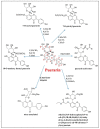Pharmacological Activity, Pharmacokinetics, and Clinical Research Progress of Puerarin
- PMID: 36358493
- PMCID: PMC9686758
- DOI: 10.3390/antiox11112121
Pharmacological Activity, Pharmacokinetics, and Clinical Research Progress of Puerarin
Abstract
As a kind of medicine and food homologous plant, kudzu root (Pueraria lobata (Willd.) Ohwi) is called an "official medicine" in Chinese folk medicine. Puerarin is the main active component extracted from kudzu root, and its structural formula is 8-β-D-grapes pyranose-4, 7-dihydroxy isoflavone, with a white needle crystal; it is slightly soluble in water, and its aqueous solution is colorless or light yellow. Puerarin is a natural antioxidant with high health value and has a series of biological activities such as antioxidation, anti-inflammation, anti-tumor effects, immunity improvement, and cardio-cerebrovascular and nerve cell protection. In particular, for the past few years, it has also been extensively used in clinical study. This review focuses on the antioxidant activity of puerarin, the therapy of diverse types of inflammatory diseases, various new drug delivery systems of puerarin, the "structure-activity relationship" of puerarin and its derivatives, and pharmacokinetic and clinical studies, which can provide a new perspective for the puerarin-related drug research and development, clinical application, and further development and utilization.
Keywords: anti-inflammation; antioxidation; clinical studies; new drug delivery systems; pharmacokinetic; pharmacological activities; puerarin.
Conflict of interest statement
The authors declare no conflict of interest.
Figures






Similar articles
-
Pharmacokinetics and drug delivery systems for puerarin, a bioactive flavone from traditional Chinese medicine.Drug Deliv. 2019 Dec;26(1):860-869. doi: 10.1080/10717544.2019.1660732. Drug Deliv. 2019. PMID: 31524010 Free PMC article. Review.
-
Advances in Extraction, Purification, and Analysis Techniques of the Main Components of Kudzu Root: A Comprehensive Review.Molecules. 2023 Sep 12;28(18):6577. doi: 10.3390/molecules28186577. Molecules. 2023. PMID: 37764353 Free PMC article. Review.
-
Puerarin: A review of its mechanisms of action and clinical studies in ophthalmology.Phytomedicine. 2022 Dec;107:154465. doi: 10.1016/j.phymed.2022.154465. Epub 2022 Sep 19. Phytomedicine. 2022. PMID: 36166943 Review.
-
Investigating the Potential Therapeutic Mechanisms of Puerarin in Neurological Diseases.Mol Neurobiol. 2024 Dec;61(12):10747-10769. doi: 10.1007/s12035-024-04222-4. Epub 2024 May 23. Mol Neurobiol. 2024. PMID: 38780722 Review.
-
Puerarin: a review of pharmacological effects.Phytother Res. 2014 Jul;28(7):961-75. doi: 10.1002/ptr.5083. Epub 2013 Dec 13. Phytother Res. 2014. PMID: 24339367 Review.
Cited by
-
Glycosylation and methylation in the biosynthesis of isoflavonoids in Pueraria lobata.Front Plant Sci. 2023 Dec 15;14:1330586. doi: 10.3389/fpls.2023.1330586. eCollection 2023. Front Plant Sci. 2023. PMID: 38162309 Free PMC article. Review.
-
Puerarin alleviates inflammation and pathological damage in colitis mice by regulating metabolism and gut microbiota.Front Microbiol. 2023 Oct 16;14:1279029. doi: 10.3389/fmicb.2023.1279029. eCollection 2023. Front Microbiol. 2023. PMID: 37908541 Free PMC article.
-
Puerarin as a multi-targeted modulator of lipid metabolism: molecular mechanisms, therapeutic potential and prospects for nutritional translation.Front Nutr. 2025 Jul 18;12:1598897. doi: 10.3389/fnut.2025.1598897. eCollection 2025. Front Nutr. 2025. PMID: 40756564 Free PMC article. Review.
-
Effect of Dietary Puerarin Supplementation on Growth Performance, Immune Response, Antioxidant Capacity, and Intestinal Morphology in Domestic Pigeons (Columba livia).J Poult Sci. 2024 Jan 26;61:2024003. doi: 10.2141/jpsa.2024003. eCollection 2024. J Poult Sci. 2024. PMID: 38283163 Free PMC article.
-
Targeting ferroptosis as a promising therapeutic strategy to treat cardiomyopathy.Front Pharmacol. 2023 Apr 13;14:1146651. doi: 10.3389/fphar.2023.1146651. eCollection 2023. Front Pharmacol. 2023. PMID: 37138856 Free PMC article. Review.
References
Publication types
Grants and funding
LinkOut - more resources
Full Text Sources
Research Materials
Miscellaneous

